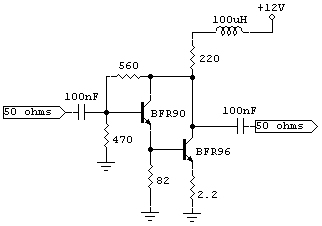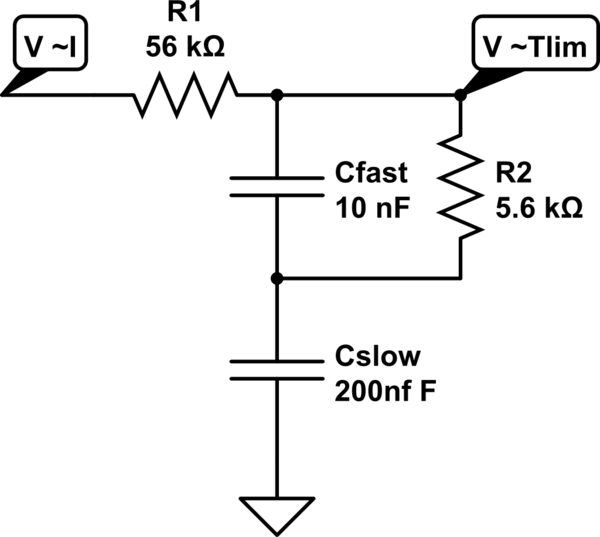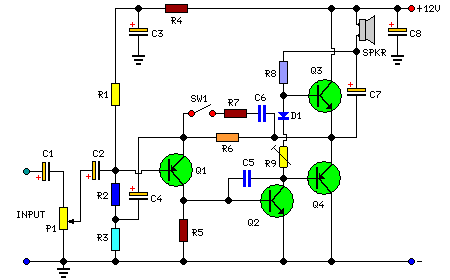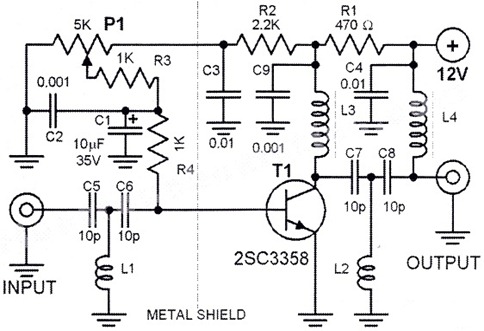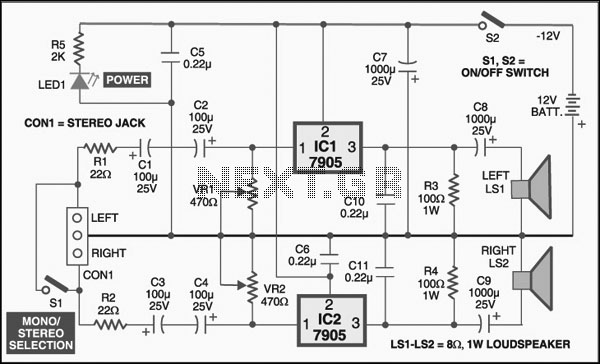
pwr amp
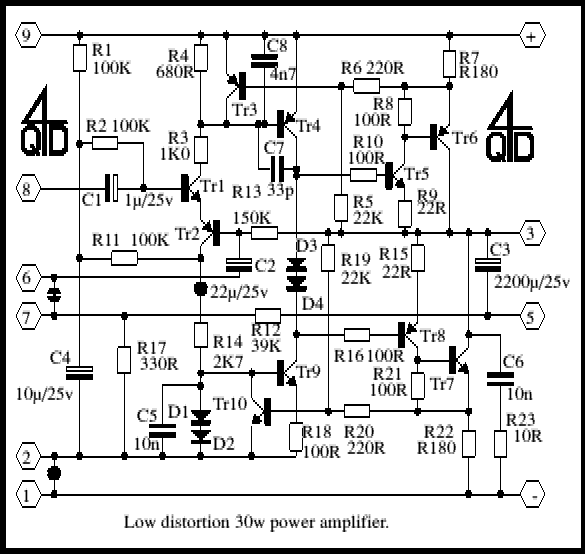
This is an unconventional circuit for an ultra-low distortion power amplifier. The circuit, noted to be from January 1977, is not modern but still sufficiently unique to warrant interest. It was designed and sold as a card by a surplus components vendor. Even with predominantly rejected transistors from manufacturers, the circuit achieved approximately 0.02% total harmonic distortion at 30 watts with a ±25V power supply into 8 ohms, a commendable figure even in the current era of MOSFETs and integrated circuits. In 1977, figures below 0.1% were considered excellent, and this performance was consistently repeatable without extensive selection. The challenge lies in the fact that modern transistor types suitable for this design are unknown, although they are not critical: the output transistors and drivers must be of the correct type, while other transistors can be small signal types, provided they can withstand the full voltage between the positive and negative supplies. Transistors Tr1 and Tr2 form a long-tailed pair (LTP), a common configuration in audio amplifiers, but this implementation is distinct as it employs a complementary LTP. To the best knowledge, this complementary LTP design was unique at the time, although it has since appeared in another circuit. A limitation of conventional LTPs is that the tail source loads the common emitters; however, in a complementary LTP, this does not occur as there is no tail current source, necessitating that all the current from one transistor flows through the other. The collector current of Tr2 flows into diodes D1 and D2, generating a voltage that is used to bias Tr8 as a constant current source for Tr4's collector. The operation of Tr4 at constant current establishes its base-emitter voltage, which must be developed across resistor R4. This defines the current in R4, which in turn dictates the operating current for the LTP, resulting in a self-biasing arrangement for the quartet of transistors (Tr1, Tr2, Tr3, and Tr4), allowing them to function optimally with minimal unwanted loads and biasing effects. Tr4 is particularly critical; in the original circuit, it was selected for a Vce greater than 75V, with most Texas BC212s meeting this criterion. Lower voltage transistors resulted in increased distortion levels. A drawback of this circuit is that, unlike conventional LTPs where base-emitter voltages tend to cancel each other, in the complementary LTP, they add, creating a voltage drop of about 1.2V between the two bases. This must be compensated for in the biasing chain, and since the circuit was designed for operation across a broad range of supply voltages, a clever solution was devised. Due to the constant current operation of the LTP and the consistent voltage drop across D1 and D2, a steady voltage is maintained across R14. This voltage drop elevates the bottom of the biasing chain (R1 and R11), ensuring that the output remains around half the supply voltage across a wider supply range. The output transistors are complementary (the original design utilized MJE2011 and MJE2021) and are driven by complementary drivers: PNP driving NPN and vice versa. This configuration not only offers pleasing symmetry but also enhances performance compared to the more common Darlington arrangement, as it utilizes the full gain of all transistors, resulting in increased internal feedback and reduced voltage drop. The output current is monitored through two resistors, R7 and R22 (180 milliohms). The current limiting feature is unconventional, operating within the input ring at an earlier stage than typical implementations. This design choice prevents the current limiting transistors from loading the drive circuitry, which could induce distortion. However, a potential downside is a slight tendency for oscillation when in current limit. Resistors R3 and R14 are essential for restricting current availability during current limiting conditions.
This circuit exemplifies innovative engineering, blending classic design principles with unique adaptations to achieve low distortion and high fidelity in audio amplification. The use of complementary LTPs and careful biasing strategies contribute to its distinctive performance characteristics, making it a noteworthy design in the evolution of audio amplification technology.This is an unusual circuit for an ultra-low distortion power amp. According to my original notes the circuit is dated January 1977 so the circuit is not exactly modern but it is still sufficiently different to be interesting. The circuit was designed and sold as a card by a purveyor of surplus components but, even using mostly manufacturer`s rejec
ted transistors, we managed to get about 0. 02% total harmonic distortion at 30 watts with a ±25v power supply into 8 ohms. : no bad figure even in these days of MOSFET and ICs. In 1977 anything below 0. 1% was considered excellent. And this figure was pretty repeatable without doing much selection. The problem of course is that since I haven`t touched this amplifier for many a year I have absolutely no idea what modern transistor types one should use for it but they are not critical: output transistors and drivers need to be the correct type but the other transistors can be small signal types - as long as they can handle the full voltage between + and - supplies. Tr1 and Tr2 are a long-tailed pair (LTP to save typing). It is quite common to have a LTP in an audio amp but this is different: this is a complimentary LTP. As far as I am aware no one else had used a complimentary LTP at the time, though I have since seen it used in one other circuit.
So I guess the circuit is unique to the author. One of the things that limits the performance of a conventional LTP is that the tail source loads the common emitters. In a complementary LTP this can`t happen as there is no tail current source so that all the current of one transistor has to flow through the other.
Tr2`s collector current flows into D1 and D2 which develop a voltage: this is used to bias Tr8 as a constant current source for Tr4`s collector. The fact that Tr4 is working at a constant current defines its base-emitter voltage which must be developed across R4.
This defines a current in R4 and this is the current that the LTP must operate at - so the ring of four transistors (Tr1, 2, 3, & 4) is self biasing and all transistors work at their best with minimum unwanted loads and biasing detracting from the performance. Tr4 is actually one of the most critical transistors: in the original circuit it was selected for Vce greater than 75v.
Most Texas BC212s passed easily. Lower voltage transistors caused an increase in distortion level. There is always a down side to any circuit: in the conventional LTP the base-emitter voltages tend to cancel each other out. In the complimentary LTP they add so there is a drop of about 1. 2v between the two bases: this must be cancelled in the biasing chain and, since this circuit was designed for operation over a wide range of supply voltage, I had to be a little clever.
Because of the constant current operation of the LTP and the constant voltage drop across D1 & D2, there is also a constant voltage across R14. This drop is used to lift up the bottom of the biasing chain (R1 and R11) so that the output sits at around half supply voltage, over a wider supply range.
The output transistors are complimentary (the original design used MJE2011 and MJE2021) and are driven by complimentary drivers: PNP driving NPN and vice versa. This arrangement is not only pleasingly symmetrical but gives better performance that the more common Darlington arrangement - the full gain of all the transistors is used and there is more internal feedback and less voltage drop.
The output current is monitored in the two resistors R7 and R22 (180 milliohms). The current limiting is unusual in that it works inside the input ring at an earlier stage than normal. This has an advantage that the current limiting transistors do not load the drive circuitry - which will introduce distortion.
The slight down side is that there may be a slight tendency to oscillation when in current limit. R3 and R14 are necessary to restrict the current availability when the current limit en 🔗 External reference
This circuit exemplifies innovative engineering, blending classic design principles with unique adaptations to achieve low distortion and high fidelity in audio amplification. The use of complementary LTPs and careful biasing strategies contribute to its distinctive performance characteristics, making it a noteworthy design in the evolution of audio amplification technology.This is an unusual circuit for an ultra-low distortion power amp. According to my original notes the circuit is dated January 1977 so the circuit is not exactly modern but it is still sufficiently different to be interesting. The circuit was designed and sold as a card by a purveyor of surplus components but, even using mostly manufacturer`s rejec
ted transistors, we managed to get about 0. 02% total harmonic distortion at 30 watts with a ±25v power supply into 8 ohms. : no bad figure even in these days of MOSFET and ICs. In 1977 anything below 0. 1% was considered excellent. And this figure was pretty repeatable without doing much selection. The problem of course is that since I haven`t touched this amplifier for many a year I have absolutely no idea what modern transistor types one should use for it but they are not critical: output transistors and drivers need to be the correct type but the other transistors can be small signal types - as long as they can handle the full voltage between + and - supplies. Tr1 and Tr2 are a long-tailed pair (LTP to save typing). It is quite common to have a LTP in an audio amp but this is different: this is a complimentary LTP. As far as I am aware no one else had used a complimentary LTP at the time, though I have since seen it used in one other circuit.
So I guess the circuit is unique to the author. One of the things that limits the performance of a conventional LTP is that the tail source loads the common emitters. In a complementary LTP this can`t happen as there is no tail current source so that all the current of one transistor has to flow through the other.
Tr2`s collector current flows into D1 and D2 which develop a voltage: this is used to bias Tr8 as a constant current source for Tr4`s collector. The fact that Tr4 is working at a constant current defines its base-emitter voltage which must be developed across R4.
This defines a current in R4 and this is the current that the LTP must operate at - so the ring of four transistors (Tr1, 2, 3, & 4) is self biasing and all transistors work at their best with minimum unwanted loads and biasing detracting from the performance. Tr4 is actually one of the most critical transistors: in the original circuit it was selected for Vce greater than 75v.
Most Texas BC212s passed easily. Lower voltage transistors caused an increase in distortion level. There is always a down side to any circuit: in the conventional LTP the base-emitter voltages tend to cancel each other out. In the complimentary LTP they add so there is a drop of about 1. 2v between the two bases: this must be cancelled in the biasing chain and, since this circuit was designed for operation over a wide range of supply voltage, I had to be a little clever.
Because of the constant current operation of the LTP and the constant voltage drop across D1 & D2, there is also a constant voltage across R14. This drop is used to lift up the bottom of the biasing chain (R1 and R11) so that the output sits at around half supply voltage, over a wider supply range.
The output transistors are complimentary (the original design used MJE2011 and MJE2021) and are driven by complimentary drivers: PNP driving NPN and vice versa. This arrangement is not only pleasingly symmetrical but gives better performance that the more common Darlington arrangement - the full gain of all the transistors is used and there is more internal feedback and less voltage drop.
The output current is monitored in the two resistors R7 and R22 (180 milliohms). The current limiting is unusual in that it works inside the input ring at an earlier stage than normal. This has an advantage that the current limiting transistors do not load the drive circuitry - which will introduce distortion.
The slight down side is that there may be a slight tendency to oscillation when in current limit. R3 and R14 are necessary to restrict the current availability when the current limit en 🔗 External reference
